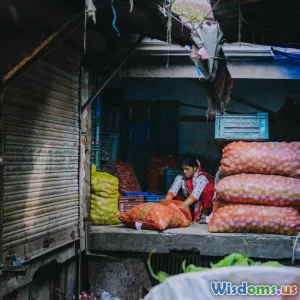
How Urban Rooftop Gardens Are Revolutionizing Local Food Supply Chains
7 min read Discover how urban rooftop gardens are transforming local food supply chains with fresh, sustainable solutions. (0 Reviews)
How Urban Rooftop Gardens Are Revolutionizing Local Food Supply Chains
Introduction
In an era marked by climate challenges, increasing urban density, and disrupted global supply chains, the way we source and consume food is under the microscope. Imagine harvesting fresh greens in the heart of a bustling city, just steps away from your kitchen. Urban rooftop gardens are making this a reality, transforming neglected spaces into thriving hubs of local food production. These gardens not only provide fresh produce where it's most needed but also reshape how food travels from farm to table, drastically impacting local food supply chains.
The Rise of Urban Rooftop Gardens: More Than Just Greenery
Urban rooftop gardening has evolved from a niche hobby to an innovative urban agriculture strategy. Cities worldwide—from New York to Tokyo—are embracing rooftops as fertile ground for growing vegetables, herbs, and even fruit. According to a 2022 report by the Food and Agriculture Organization (FAO), urban agriculture—including rooftop farming—has the potential to supply up to 15% of global food demand.
Why Rooftops?
Urban rooftops remain largely underused, representing an untapped resource for enhancing food security. They offer the benefit of proximity, reducing the distance food must travel and consequently lowering transportation emissions and spoilage. In cities like Singapore, where land scarcity is a challenge, vertical rooftop farms maximize space utilization while boosting local supply.
Revolutionizing Supply Chains Through Localization
Shortening the Farm-to-Table Distance
Traditional food supply chains often involve long transit routes with multiple intermediaries which can lead to increased costs, carbon emissions, and food waste. Rooftop gardens disrupt this chain by growing food at the point of consumption. This hyper-localization is exemplified by companies like Gotham Greens in the US, which operate rooftop greenhouses producing tens of thousands of pounds of leafy greens annually, directly supplying local grocery stores and restaurants.
Enhancing Freshness and Nutritional Value
Produce harvested minutes before consumption retains higher nutrient levels and freshness compared to food transported over days or weeks. Research from the University of California shows that nutrient degradation accelerates after harvest, especially while in transit. Rooftop gardens combat this by drastically cutting time between harvest and consumption, thus improving public health outcomes.
Environmental and Economic Benefits
Reducing Carbon Footprint
Transport accounts for about 10% of total greenhouse gas emissions globally. By growing food on rooftops, cities can significantly trim emissions associated with transportation and refrigeration. Additionally, green rooftops contribute to urban heat island reduction and stormwater management, enhancing the overall urban environment.
Creating Economic Opportunities
Urban rooftop gardens also spark new economic models. Many gardens operate as cooperatives or social enterprises creating jobs and training programs. For instance, the London-based initiative 'Incredible Edible' uses community rooftop gardens to engage citizens in food production, fostering entrepreneurship and community resilience.
Social Impact and Community Engagement
Building Community Connections
Rooftop gardens act as green oases and social spaces fostering community interaction and education. Schools integrate rooftop gardens into curriculums to teach students about ecology and nutrition, inspiring the next generation of urban farmers.
Food Justice and Accessibility
By situating food production within the city, rooftop gardens can improve food access in underserved neighborhoods. Projects like Detroit's urban rooftop farms address food deserts by providing affordable fresh food and empowering local residents with farming skills.
Technological Innovations Fueling Growth
Technologies such as hydroponics and aeroponics enable high yields in limited spaces, making rooftop farms more productive. Controlled environment agriculture, including LED lighting and automated irrigation, optimizes growth conditions year-round regardless of weather.
Companies like Freight Farms repurpose shipping containers into modular urban farms deployable on rooftops, further democratizing fresh food production.
Challenges and Future Prospects
Despite these advantages, rooftop gardens face challenges such as structural limitations, initial costs, and regulatory hurdles. However, growing governmental support, including grants and incentives in cities like Toronto and Berlin, signals a bright future.
Scaling for Impact
Expanding rooftop agriculture requires collaboration between policymakers, architects, businesses, and communities to integrate agricultural systems into urban design from the outset.
Conclusion
Urban rooftop gardens are no longer just aesthetic additions to city skylines. They are a transformative force reshaping local food supply chains by shortening distances, reducing environmental impact, and enhancing access to fresh, nutritious food. As we seek resilient and sustainable urban futures, rooftop gardens offer a green, fruitful solution growing literally above our heads—one garden at a time.
Embracing rooftop gardens is more than a trend; it's a strategic shift towards sustainable, resilient cities and equitable food systems. Are you ready to green your rooftop and harvest the future?
Rate the Post
User Reviews
Popular Posts


















